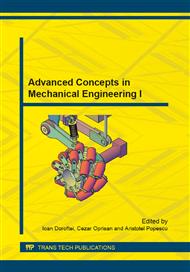[1]
G.R. Hamilton and C. Reinschmidt, Optimal trajectory for the basketball free throw, Journal of Sports Sciences, 15(5), pp.491-504 (1997).
DOI: 10.1080/026404197367137
Google Scholar
[2]
L. Silverberg, C., Tran, and K. Adcock, Numerical analysis of the basketball shot, Journal of Dynamic Systems Measurement and Control-Transactions of the ASME, 125(4), pp.531-540, (2003).
DOI: 10.1115/1.1636193
Google Scholar
[3]
C.M. Tran and L.M. Silverberg, Optimal release conditions for the free throw in men's basketball, Journal of Sports Sciences, 26(11), pp.1147-1155 (2008).
DOI: 10.1080/02640410802004948
Google Scholar
[4]
E. Budescu, Eug. Merticaru and R.M. Iacob, Inverse kinematics in the success of the throw in basketball game, Scientific Proceedings of 27-th International Conference on Biomechanics in Sports, Limerick, Irlanda, pp.158-161, www. researchgate. net/publication (2009).
Google Scholar
[5]
H. Okubo and M. Hubbard, Dynamics of the basketball shot with application to the free throw, Journal of Sports Sciences, 24(12), pp.1303-1314 (2006).
DOI: 10.1080/02640410500520401
Google Scholar
[6]
C. Button, M. MacLeod, R. Sanders and S. Coleman, Examining movement variability in the basketball free-throw action at different skill levels, Res Q Exerc Sport, 74(3), pp.257-269 (2003).
DOI: 10.1080/02701367.2003.10609090
Google Scholar
[7]
H. Müller, Ausführungsvariabilität und Ergebniskonstanz, Lengerich Pabst Science Publ. (2001).
Google Scholar
[8]
M. Hirashima, H. Kadota, S. Sakurai, K. Kudo and T. Ohtsuki, Sequential muscle activity and its functional role in the upper extremity and trunk during overarm throwing, Journal of Sports Sciences, 20(4), pp.301-310 (2002).
DOI: 10.1080/026404102753576071
Google Scholar
[9]
Y.T. Liu, H.Y. Chiang and G. Mayer-Kress, Variability in accuracy: Movement degeneracy in basketball clean shot, Journal of Biomechanics, 39(Supl. ), pp.189-190 (2006).
DOI: 10.1016/s0021-9290(06)83679-1
Google Scholar
[10]
H.Y. Chiang, Coordination of basketball shooting movement of different skill level players, Paper presented at the 24th ISBS Salzburg – Austria, (2006).
Google Scholar
[11]
S.H.T. Toyoshima, M. Miyashita, T. Oguri, Contributions of body parts to throwing performance, in Biomechanics IV, Proceedings of the Fourth International Seminar on Biomechanics, Baltimore University Park Press, pp.169-174 (1974).
DOI: 10.1007/978-1-349-02612-8_24
Google Scholar
[12]
S. Sakurai and T. Ohtsuki, Muscle activity and accuracy of performance of the smash stroke in badminton with reference to skill and practice, Journal of Sports Sciences, 18(11), pp.901-914 (2000).
DOI: 10.1080/026404100750017832
Google Scholar
[13]
J. Hore, S. Watts, J. Martin. and B. Miller, Timing of Finger Opening and Ball Release in Fast and Accurate Overarm Throws, Experimental Brain Research, 103(2), pp.277-286 (1995).
DOI: 10.1007/bf00231714
Google Scholar
[14]
J. Hore, S. Watts and J. Martin, Finger flexion does not contribute to ball speed in overarm throws, Journal of Sports Sciences, 14(4), pp.335-342 (1996).
DOI: 10.1080/026404196367813
Google Scholar
[15]
J. Schroder and C. Bauer, Basketball trainiren und spielen, Rowohlt Taschenbuch Verlag GmbH, Germany, (1996).
Google Scholar
[16]
E. Budescu, R.M. Iacob and Eug. Merticaru, Setup of the basketball player position in the field on throwing in the basket game, Gymnasium – Scientific Journal of Education, Sports and Health, 14(2), pp.28-44 (2013).
Google Scholar


